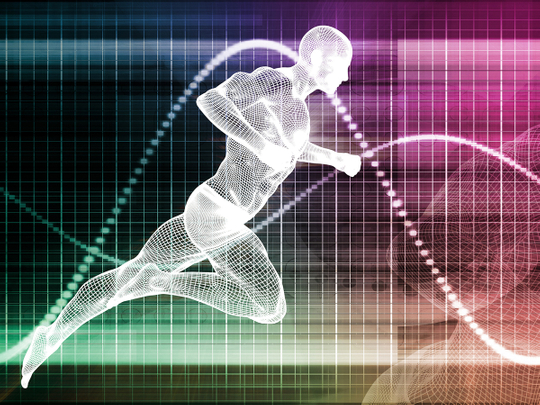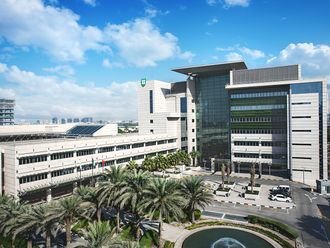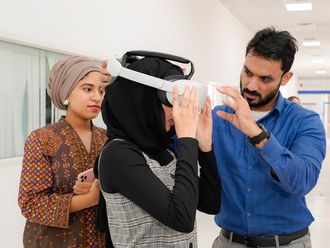
Last month, Swiss scientists were able to restore three paralysed patients’ ability to walk. The breakthrough made headlines across the world. The specialists achieved this using precise electrical stimulation of their spinal cord via a wireless implant. The scientists said that they were able to mimic the way the brain activates the spinal cord in real time.
When electrical stimulation was applied, the three paraplegics were able to walk — using an intelligent bodyweight system — for a distance of over one kilometre, hands-free. The scientists believe that the level of precision they achieved in spinal cord stimulation has the potential to transform the lives of people with such injuries.
Dr Suad Trebinjac, Medical Director of the Dubai Physiotherapy and Rehabilitation Centre, says electrical stimulation has been used in the past but the results weren’t significant. He compares paralysis caused by severe spinal cord injuries to the cutting of an electrical wire. “When the connection between the body and the lower part of the brain is broken, it’s the same as the impulses, which are coming from the brain. Before reaching the legs and allowing movement, they are cut.” Dr Trebinjac is also cautious about the Swiss research, saying more information about the three patients’ medical history and the precise nature of their injuries is required before the results can be verified.
The Swiss start-up behind the research, GTX medical, is planning to tailor its neurotechnology so that its paradigm of rehabilitation becomes available at clinics and hospitals across the world.
Dr Trebinjac says that the paradigms of rehabilitation are already evolving rapidly, particularly in the musculoskeletal field where regenerative drugs are widely used. “The paradigm has completely changed from 10-15 years ago. Previously, we provided symptomatic treatment, where we were not able to recover or regenerate any structures. It was mainly physiotherapy, exercise, pain moderators and anti-inflammatory medicines. Now we are following treatments that slow down the degeneration of the patients’ structures.” He refers to the use of prolotherapy injections, which are a regenerative therapy that stimulate the body’s natural healing processes.

Technology can help, but it cannot solve all problems.
Advanced technology
At Dubai Physiotherapy and Rehabilitation Centre, spinal injury patients have been treated with a G-EO system for several years. The G-EO is a robotic-assisted device that is used for gait rehabilitation. “You programme the robot to the parameters that you want. You can provide the speed, the resistance to the muscles and the incline of the exercise,” says Dr Trebinjac. “If the muscles are preserved, then we try to stimulate these muscles. For patients who are completely paralysed, the machine moves patients’ legs passively and it helps circulate the blood, but it will not help these patients to be able to walk again.
“If there is a certain potential in the muscles in the lower limbs, which is a partial spinal cord injury, then we use the machine to build this potential to its maximum. This means training the muscles to be as strong as possible and improving the balance and coordination and after a certain period of training, the patients improve. For many patients who were initially in a wheelchair, with a certain type of training, they are able to walk again.”
The future of treatment
One area where treatments have advanced is in stem cells, mesenchymal stem cells in particular. Mesenchymal stem cells are multipotent cells that can produce more than one specialised cell in the body such as cells found in skeletal tissue, cartilage and fat. “Embryonic stem cells are illegal in this country but the stem cells that are harvested from bone marrow have been proved to be safe and helpful in the recovery process of chronic muscular skeletal conditions, so this is a new trend in the rehabilitation field,” says Dr Trebinjac .
“You harvest the cells from the body of the patient, process the cells in a machine and then they are injected into the damaged structure, whether it is tendons, ligaments or muscles. This is something that we are trying to develop at DHA.”
Technology is also advancing robotic-assisted devices to the point where Dr Trebinjac anticipates patients being able to continue their rehabilitation beyond the confines of a rehab centre. He also believes virtual reality technology will allow them to do so with immersive experiences, where they receive feedback on their progress. He also refers to the potential of technology for further integrating patients into everyday society.
Yet, Dr Trebinjac emphasises that technology alone will not necessarily solve all of the challenges faced by people with spinal cord injuries.
“Any new technology or treatments in the market are usually highly expensive, so I hope that this high technology becomes more affordable to centres and patients over time. High prices must not be a barrier but we must also understand that, while technology can help, it cannot solve all problems. A lot of recovery is related to a patient’s motivation and their attitude to life — this is also very important to accept.”












